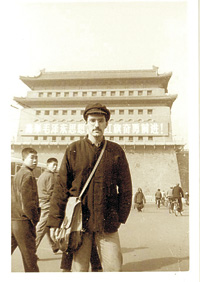By Diana Brement,
JTNews Columnist
Although Rabbi Anson Laytner has served in a variety of professional positions in Seattle over the years, and is currently the director of the Greater Seattle chapter of the American Jewish Committee, he’s had a long standing avocation as a member of the Sino-Judaic Institute (www.sino-judaic.org), which just elected him president of their board.
Laytner majored in Chinese studies at York University in Toronto, and visited China in 1973. He tried then to visit Kaifeng, home of a centuries-old Chinese-Jewish community, but it was closed to foreigners.
“When I went to Hebrew Union College in Cincinnati,” says Laytner, “I found they had a large collection of Kaifeng Jewish manuscripts. The librarians there fueled my interest. They put me in touch with a man named Michael Pollak, the author of Mandarins, Jews and Missionaries.”
Through Pollak, Laytner met others interested in the subject and was invited to a meeting at which the Sino-Judaic Institute was founded in 1986. He has been editing their journal, Points East, since that time.
Until the establishment of Israeli-Chinese diplomatic relations in 1992, the institute provided one of the few connections between Jewish and Chinese scholars studying Jews in China.
“We did things like send them books and translated Jewish materials into Chinese…funded conferences…and published both Chinese and Jewish scholars in our newsletter,” Laytner says.
Those 15 years of diplomatic relations has “changed everything,” says Laytner. Now Chinese and Israeli universities have exchange programs and Jewish studies are taught at some Chinese universities.
“It’s wonderful,” he continues, “but it creates a big question mark for the institute. We’re not playing the same role we played before.”
There are several Chinese-Jewish communities, by the way. Kaifeng’s stems from Persian Jewish traders who came to China on the Silk Road, stayed, and married local women. Russian Jews emigrated to Harbin for various reasons from the mid-19th to early 20th centuries. Holocaust refugees arrived in large numbers in Shanghai, where they waited to emigrate to other countries and many were aided by Shanghai’s small community of Baghdadi-Jewish merchants.
Why would the Chinese be interested in the Jews? Anson suspects it might be the cultural and historic similarities (he’d like someone to study this). Chinese culture emphasizes education and Chinese merchants settled and built communities around East Asia and, like the Jews, often were targets of persecution during economic or political crises.
An even newer focus of scholars is the Chinese-Jewish community that is growing in the United States through adoption.
The institute continues to be interested in collecting stories of Jewish refugee experiences in Shanghai or Harbin. If you have a story to tell that has not been told yet, please contact Laytner at the AJC office at 206-622-6315.
|||
Each year a select group of American middle- and high-school teachers heads to New York City to learn how to teach, or better teach, the Holocaust. They attend a program sponsored by the Jewish Foundation for the Righteous, an intensive academic seminar featuring lectures by Holocaust survivors and renowned Holocaust scholars.
Participants meet in small groups following lectures to share teaching concepts and develop approaches to help students connect to the subject matter.
This year, Washington State was represented by Jo Cripps from Seattle’s Summit K-12 alternative school and by Ann Gilbert, an 8th Grade English teacher at Forest Ridge, a Catholic girls’ school in Bellevue.
Gilbert says she teaches the Holocaust every year, using the memoir All But My Life by Gerda Weissmann Klein.
The experience is so powerful that Gilbert asked herself, “How do you end it? Do you give a test?”
She felt “it didn’t seem right,” she says, “So I let my students make a memorial museum. There are three separate committees: art, music and commentary, and I turn them loose…It’s an amazing thing that they do.”
Gilbert met Ilana Kennedy of the Washington State Holocaust Resource Center at a workshop and invited her to view the museum. Kennedy then nominated Gilbert for the JFR program.
“I met 30 wonderful people,” says Gilbert of the other teachers at seminar. She had high praise for Stanlee Stahl, the JFR’s executive director, and her staff who did “everything they could” to make them comfortable and arranged activities for the evenings, including a Mets game viewed from the owner’s box.
“They gave us so much wonderful material,” says Gilbert, “it’s going to take me all summer to go through it.”
That was in addition to the 1,200 pages of reading assigned before the seminar began.
Gilbert has been teaching for 31 years, most of it in South Dakota where she taught in the Rapid City public schools and at Oglalla-Lakota College at night. She taught for five years in an international school in Tokyo and then followed her kids to the Seattle area six years ago.
